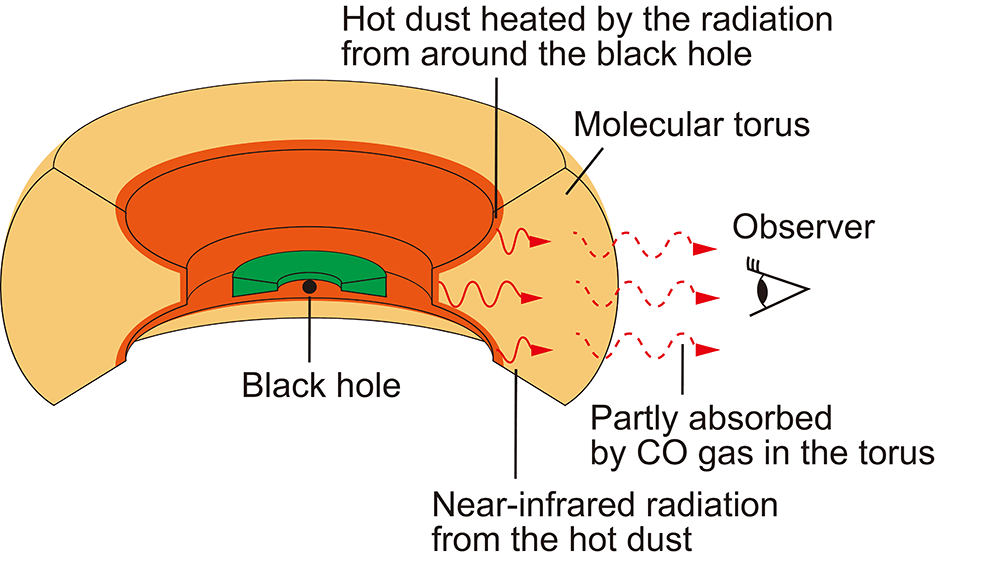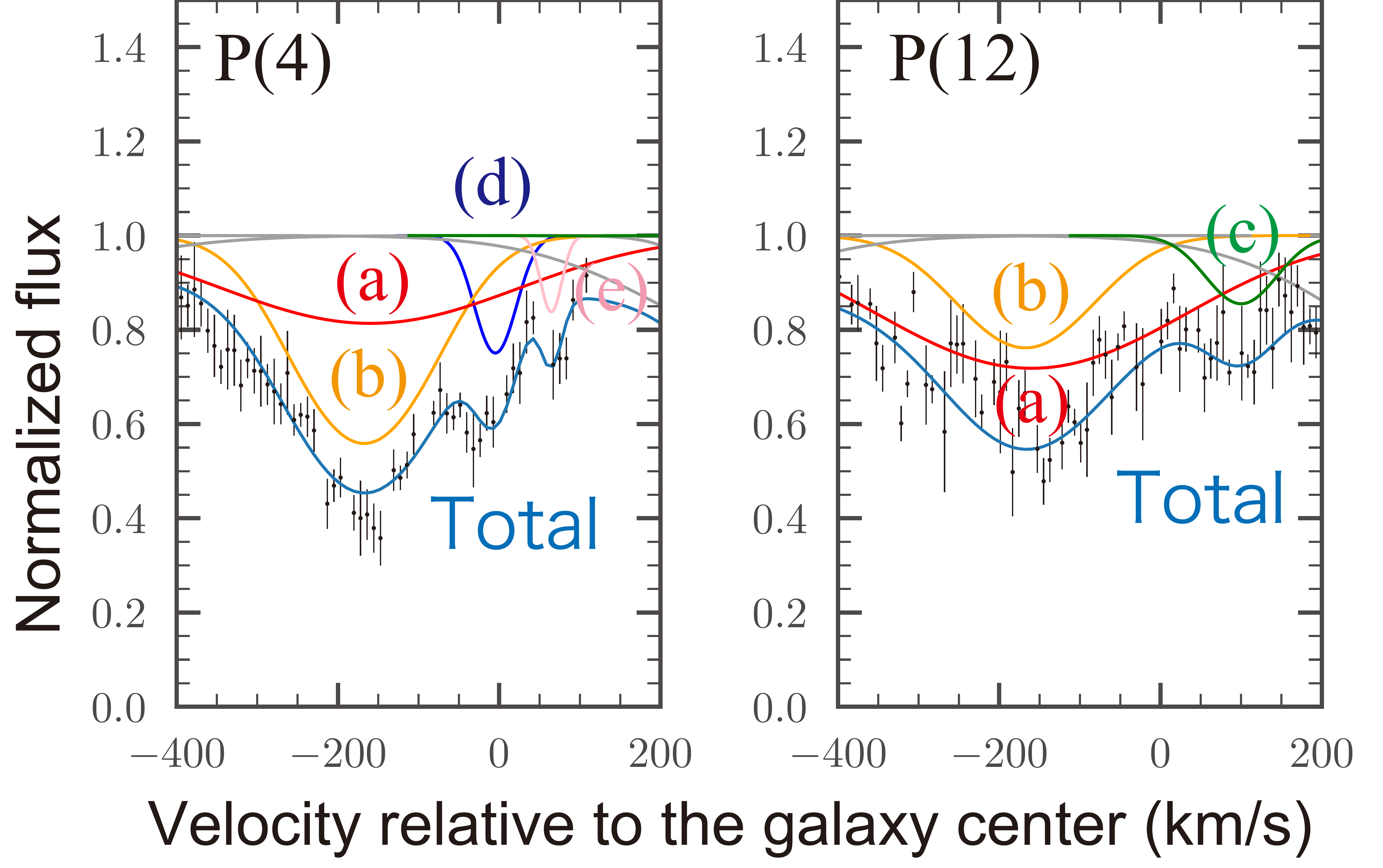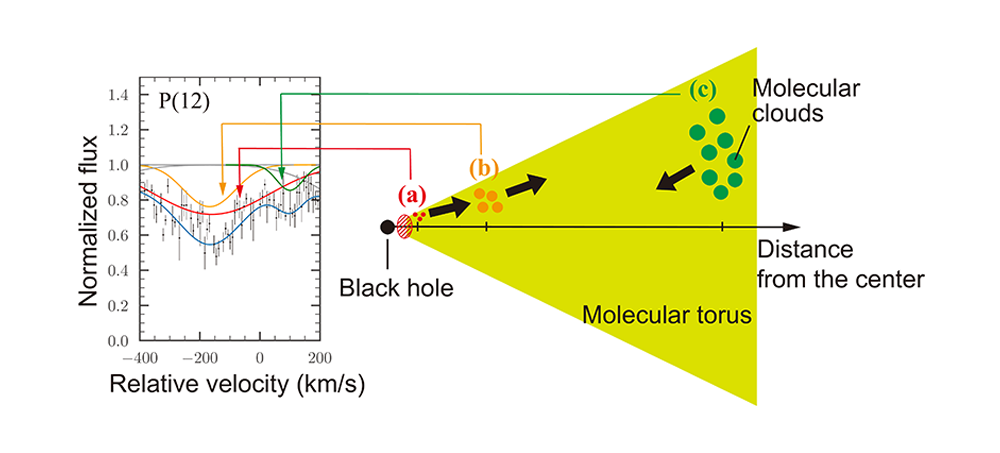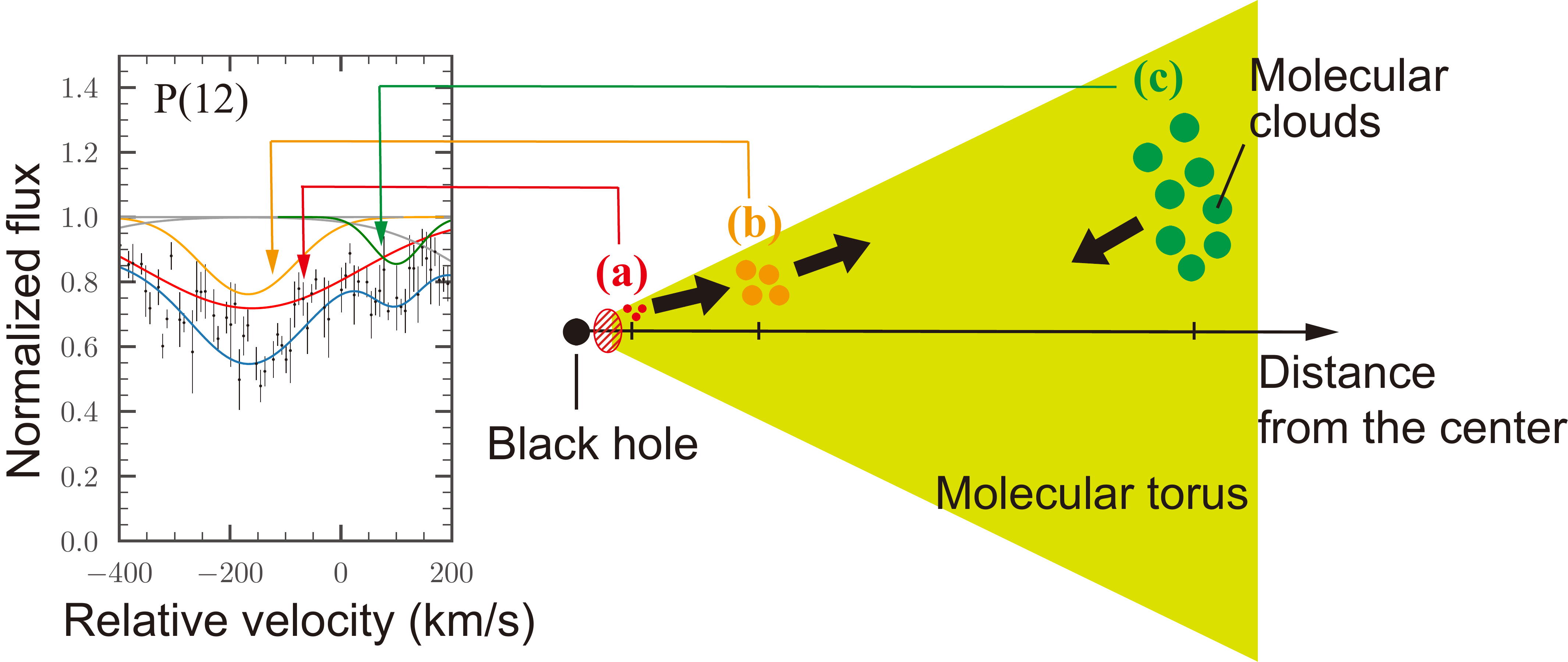Inner structure of the doughnut-shaped molecular gas surrounding a black hole at the galactic center revealed with absorption lines of carbon monoxide
Nov. 19, 2021 | GATEWAY to Academic Articles
Today, it is believed that there is a supermassive black hole at the center of most galaxies. Many galaxies are observed to host “active galactic nuclei”, which form the bright central region of the galaxy and shine due to gas accreting onto the central black hole. Studying these active galactic nuclei is important for understanding galaxy evolution because their huge energy radiation impacts the evolution of the host galaxy. The characteristics of the active galactic nucleus are believed to be affected by a doughnut-shaped gas structure surrounding the central black hole, which is known as the “molecular torus”; thus, understanding the inner structure of the molecular torus is essential to understanding both the active galactic nuclei and so the evolution of the galaxy. However, imaging the inner structure of the torus is difficult because the diameter of the torus is about 1/10,000th of that of the host galaxy.
In this research, we were able to probe the inner structure of the molecular torus in the active galactic nucleus of the galaxy IRAS 08572+3915 by making spectroscopic observations of the near-infrared absorption lines of the carbon monoxide molecules within the torus, rather than imaging the torus itself. As a result, it was found observationally that (1) the interior of the molecular torus is not composed of continuous gas but of discrete clouds of molecular gas, and forms a dynamic structure where these molecular clouds are inflowing or outflowing, and (2) the molecular clouds are dense gas with various temperatures ranging from approximately 30 to 700 K.
Research Summary
Today, it is believed that there is a supermassive black hole*1 at the center of most galaxies. For active galaxies, the central region is known as the “active galactic nucleus” and shines brightly as gas falls onto such a black hole and releases energy. The huge energy radiation from the nucleus is expected to affect the evolution of the host galaxy. Thus, active galactic nuclei are important objects for studying galaxy evolution.

Active galactic nuclei are classified into two types: type 1, which shows broad emission lines*2 in the spectroscopy*3 of visible light, and type 2, which does not. At present, the expected reason for these differences is that there is a doughnut-shaped gaseous structure surrounding the central black hole, which is called the “molecular torus”. If such a structure exists, the torus can create the apparent difference through variations in the line-of-sight inclination that can interrupt broad emission lines from the central region around the black hole at some orientations, although the two types of nuclei actually have identical structures. The torus is also expected to be a reservoir of gas, which is necessary for the active galactic nucleus to shine brightly. Accordingly, revealing the inner structure of the molecular torus is essential to understanding the active galactic nucleus because the torus impacts the characteristics of the nucleus. However, because the diameter of the molecular torus is only about 1/10,000th of that of the host galaxy, its inner structure is difficult to image directly and remains unclear.
In this work, we investigated the inner structure of the molecular torus in the active galactic nucleus of the ultraluminous infrared galaxy*4 IRAS 08572+3915 by observing the near-infrared absorption lines (rovibrational absorption lines*5) of carbon monoxide (CO) gas in the torus using the high-dispersion spectroscopy*3 of the Subaru Telescope*6, instead of attempting to image the torus directly (Figure 1).

As a result of the velocity decomposition*7 of the observed absorption lines, it was found that there were several velocity components with individual velocity centers and widths in each CO absorption line, as shown in Figure 2. This suggests that the CO gas in the molecular torus does not have a continuous spatial distribution but has a discrete structure consisting of clouds of molecular gas. In addition, we investigated the motion and spatial location of these molecular clouds based on the observed absorption lines as follows. First, the Doppler effect*8 caused by the motion of the clouds makes the wavelength centers of the absorption lines deviate from the original wavelength, and this can be used to estimate the direction of motion of the clouds along the line of sight, i.e., whether the clouds are outflowing or inflowing. Second, we can estimate the relative distance of the clouds to the black hole from the velocity width by assuming a dynamically stable torus, because the further away from the center black hole the gas is, the narrower the velocity width of the absorption lines are expected to be. From these results, we found that the molecular torus is likely to have a dynamic inner structure, where the molecular clouds are outflowing at the inner side and inflowing at the outer side, as shown in Figure 3. In addition, based on the depth of the absorption of each component for several excitation states*9, we also find that the molecular torus is composed of dense molecular clouds at various temperatures ranging from approximately 30 to 700 K.

Although previous work had shown that there were some velocity components in near-infrared absorption lines of CO gas, these had not been previously decomposed. This work has performed the velocity decomposition for the first time, and it has been found observationally that the molecular torus has a dynamic structure composed of dense molecular clouds at various temperatures. This marks a milestone in the observational studies of the inner structure of the torus using the high-dispersion spectroscopy of the near infrared absorption lines of CO gas. In the future, by applying this method, which is completely different from conventional direct imaging, to other active galactic nuclei, we will be able to probe the inner structure of molecular tori systematically and study active galactic nuclei with this unique approach.
Terminologies
- *1 supermassive black hole: A black hole with a mass exceeding a hundred thousand to a million solar mass.
- *2 emission (absorption) line: The bright (dark) part of a spectrum at a given wavelength. Lines occur at a unique wavelength depending on the species of atoms and molecules and their energy states.
- *3 spectroscopy, high-dispersion spectroscopy: To divide light into different wavelengths. Unlike imaging, it observes the spectrum, which is the brightness of each wavelength. Spectroscopy with high wavelength resolution is called high-dispersion spectroscopy, which can accurately capture gas motion at the velocity of several tens of km/s.
- *4 ultraluminous infrared galaxy: A galaxy whose infrared brightness (luminosity) is more than one trillion solar luminosity.
- *5 rovibrational absorption line: Absorption lines of gaseous CO molecules in the near-infrared wavelength (around 4.67 μm). Absorption lines attributed to multiple excitation levels are observed in a narrow wavelength range.
- *6 Subaru Telescope: An optical infrared telescope built by the National Astronomical Observatory of Japan (NAOJ) at the summit of Mauna Kea (4205 m above sea level) on the island of Hawaii, USA. It is capable of performing high-dispersion spectroscopic observations in the near-infrared wavelength.
- *7 velocity decomposition: A method of dividing absorption-line components according to the kinetic state of a gas by fitting the sum of gas models with several different velocity centers and velocity widths to the absorption lines observed by spectroscopy and reproducing their shape.
- *8 Doppler effect: A phenomenon in which the wavelength of sound or light varies by the motion of the source or the observer. The Doppler effect of light is used in this work. The observed wavelength of absorption lines becomes shorter than the original wavelength when the molecular clouds are moving toward the Earth and longer than the original wavelength when they are moving away from the Earth.
- *9 excitation state: The unique energy states that a quantum, such as an atom, a molecule, or an ion, can have. A quantum can not have all energy states continuously but can have only the unique energy states which distribute discretely.
Information
| Journal Title | The Astrophysical Journal (ApJ) |
|---|---|
| Full title of the paper | Study of the Inner Structure of the Molecular Torus in IRAS 08572+3915 NW with Velocity Decomposition of CO Rovibrational Absorption Lines |
| DOI | https://doi.org/10.3847/1538-4357/ac1c6d |
| Publish date | 9 November 2021 |
| Author(s) | Shusuke Onishi, Takao Nakagawa, Shunsuke Baba, Kosei Matsumoto, Naoki Isobe, Mai Shirahata, Hiroshi Terada, Tomonori Usuda, Shinki Oyabu |
| ISAS or JAXA member(s) among author(s) | Shusuke Onishi (Dept. of Space Astronomy and Astrophysics, ISAS/Dept. of Physics, Graduate School of Science, The University of Tokyo), Takao Nakagawa (Dept. of Space Astronomy and Astrophysics, ISAS), Kosei Matsumoto (Dept. of Space Astronomy and Astrophysics, ISAS/Dept. of Physics, Graduate School of Science, The University of Tokyo), Naoki Isobe (Dept. of Space Astronomy and Astrophysics, ISAS) |


 ONISHI Shusuke / Graduate School of Science, The University of Tokyo,
ONISHI Shusuke / Graduate School of Science, The University of Tokyo, 
